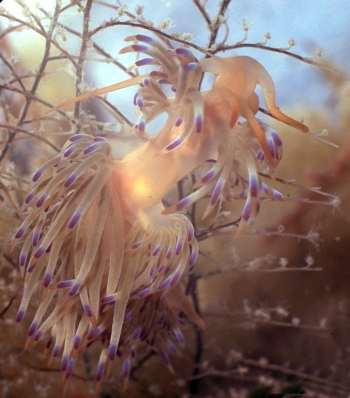
Sakuraeolis kirembosa
Rudman, 1980
Order: NUDIBRANCHIA
Suborder: AEOLIDINA
Family: Glaucidae
DISTRIBUTION
Known only from Tanzania
PHOTO
North Reef, entrance to Dar es Salaam Harbour, Tanzania. on hydroid Eudendrium sp. cf. carneum Clarke, 1882, intertidally. 40 mm long alive, 29 Sept. 1977, Holotype, AM C111481. Photos: Bill Rudman.
Head and body a milky translucent orange colour, with body darkening behind the second ceratal arch to a deeper orange where the gonads show through. The oral tentacles are long and tapering and about one and a half times the length of the rhinophores. The basal half of each oral tentacle is transparent with the distal half being milky orange. The basal third of the rhinophores is transparent, while the upper two thirds is a milky orange. The rhinophores have scattered, rounded bumps all over them. The foot is translucent with a faint orange tinge, the anterior end producing long, tapering foot corners. A median band of orange runs to the tip of the tail from between the most posterior cerata. The cerata are arranged into six pairs of multi-rowed arches each raised on a pad, and there is also a group of irregularly arranged cerata at the posterior end of the body. The lower three quarters of each ceras is translucent, with dense white speckling, which obscures the digestive gland duct. The upper quarter of each cerata is quite colourful, with a milky orange tip, and then below that a bright purple region, and below that a dull greenish brown section. The purple and greenish brown regions are sections of the digestive gland duct visible through the transparent ceratal wall, while the orange tip is due to pigmentation on the ceratal wall.
As in other species of the genus, the cerata are long and slender, and are held out from the body in large clumps.
-
Rudman, W.B. (1980) Aeolid opisthobranch molluscs (Glaucidae) from the Indian Ocean and the south-west Pacific. Zoological Journal of the Linnean Society, 68: 139-172.
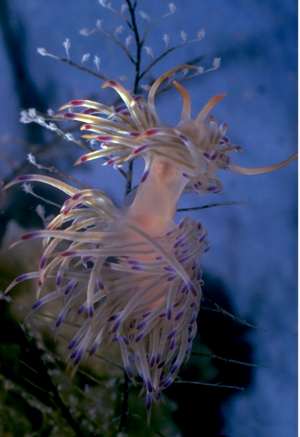
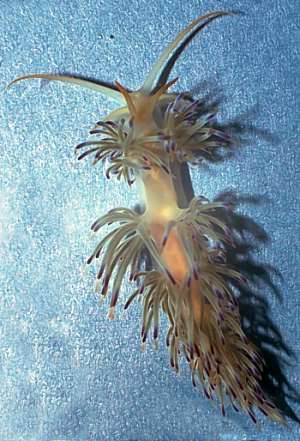
Rudman, W.B., 2004 (December 28) Sakuraeolis kirembosa Rudman, 1980. [In] Sea Slug Forum. Australian Museum, Sydney. Available from http://www.seaslugforum.net/find/sakukire
Related messages
Sakuraeolis kirembosa from the Gulf of Oman
February 27, 2007
From: Dragan Petkovic
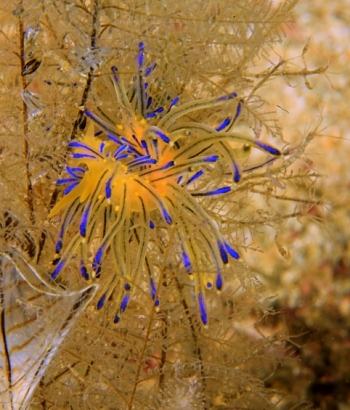
Dear, dr. Bill,
Please find the pictures from today's dive attached. Looks like Flabellina, but could not find it anywhere. Could you please help?
Locality: Khor Fakkan , 20 m, UAE, Gulf of Oman, Indian Ocean, 25 February 2007, Sandy . Length: 30 mm. Photographer: Dragan Petkovic.
Many thanks,
Dragan Petkovic
machodiver@gmail.com
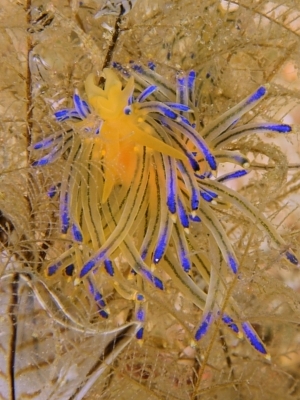
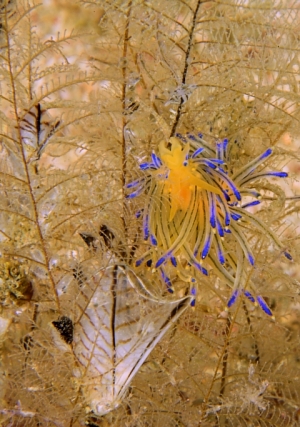
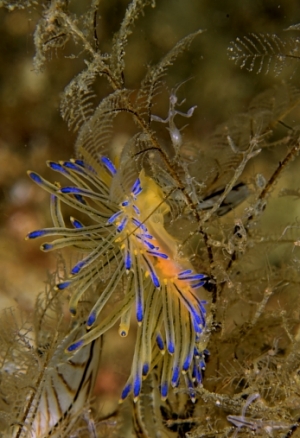
Dear Dragan,
As soon as I saw your photos it reminded me of a species I collected 30 years ago in Dar es Salaam and named Sakuraeolis kirembosa. Even the hydroid it is feeding on looks very similar to the Eudendrium my Tanzanian animal was living on. We would need to look at its anatomy to be 100% sure, but the translucent orange body, the thin blackish digestive gland ducts in the cerata, the blue patch at the tips of the cerata and the smooth rhinophores are all very similar. My photos on the species Fact Sheet are very dull and don't do this species justice - I was short of film and my flash lights weren't synchronising with my old cameras' shutter. The name kirembosa is from a Swahili word for beautiful - which your photos clearly demonstrate.
It is a nice find. As far as I know this is only the second time this animal has been reported.
Best wishes,
Bill Rudman
